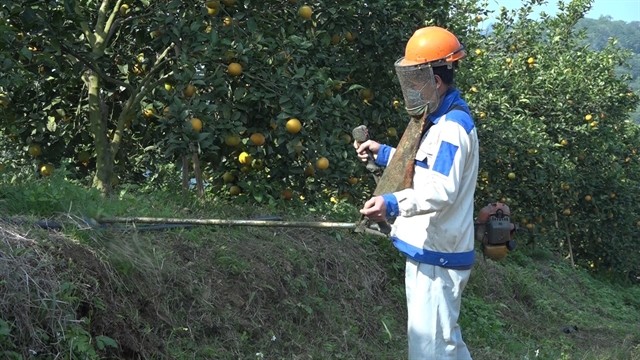 Society
Society

 |
| A farmer sprays chemical substances to limit harmful insects in an orange garden in Lục Yên District, Yên Bái Province. — VNA/VNS Photo Việt Dũng |
YÊN BÁI — In recent years, policies supporting sustainable development in Yên Bái Province, such as cooperation and investment in fruit trees, have helped to improve their quality.
The province now has more than 10,000ha of fruit trees, increasing yearly.
Some fruit tree areas have a capacity of 90 quintals per hectare, producing more than 36,000 tonnes per year.
The areas produced based on VietGAP (Vietnamese Good Agricultural Practices) and GlobalGAP increased more and more by about 1,500ha. Most of them are in Văn Chấn, Trấn Yên, Lục Yên and Yên Bình districts.
The provincial Department of Agriculture and Rural Development (DARD) said that the areas which can be transferred to plant fruit trees were plentiful.
Several kinds of fruit trees are successfully planted in pilot programmes in mountainous districts.
The province is carefully researching a plan for fruit trees development to be suitable for different kinds of trees, and production must go together with processing and the market’s demand.
Nguyễn Đức Điển, deputy director of the Yên Bái DARD, said that professional organisations were trying to give consultancy to the provincial authorities to expand planting areas.
After many years of experimental planting of new fruit tree varieties, the province has formed large-scale fruit-growing regions.
That has created favourable conditions for production mechanisation, science and technology application and pest control.
The province has selected and hybridised fruit tree varieties with high yield and quality.
Besides developing agricultural promotion programmes on advanced farming, the province supports fertilisers and plant protection substances for new cultivation areas.
It supports varieties to replace old, low-yielding fruit trees to have ones with high economic value.
Giàng A Câu, chairman of the Yên Bái Farmers’ Association, said that thanks to training classes, all local farmers changed their planting habits.
They proficiently use fertilisers and plant protection substances for each type of tree and each period of the tree’s development.
They have experience and creativity in caring for the trees, from flowering to harvesting and preserving fruit. That increases the fruit quality and makes it easier to sell products.
Typically, Đại Minh Commune in Yên Bình District developed nearly 800 hectares of grapefruit. The average output is 15,000 tonnes annually, with a value of VNĐ250 billion (US$10.5 million).
Tạ Quang Công, chairman of the Đại Minh Commune People’s Committee, said that thanks to practical support policies and stable products output, the number of households growing grapefruit increased.
The grapefruit is certified for safe production and meet the four-star standard of OCOP (one commune, one product programme) at the provincial level.
More than 3,000 households in the commune specialised in grapefruit cultivation. Now grapefruit trees enrich local people.
Investment cooperation
Yên Bái Province is creating cooperation policies, linking sustainable chains between growers and enterprises processing and consuming products.
Lục Yên District recently has successfully tested and replicated several kinds of fruit trees, such as oranges, pomelo, lemon and jackfruit, based on VietGAP standards.
The district now has 1,000ha, of which about 650ha gave products with an output of about 8,500 tonnes per year.
Đinh Khắc Yên, chairman of the Lục Yên District People’s Committee, said that the district invited capable enterprises cooperatives to invest in the growing.
It prioritises local businesses to implement projects linking production with processing and consuming products.
Under the projects, enterprises provide seeds, fertilisers, planting techniques, care and sell products based on contracts.
Thanks to the linkage model, mountainous districts formed fruit tree areas, including 350ha of green plums, 150ha of pears, and 150ha of peaches.
The areas also develop tourism programmes.
The districts also have pilot models of new high-value fruit trees, such as crisp persimmon and red plum, with an area of more than 200ha. The models promise to become high-quality fruit tree areas in the future.
Sùng A Chua, deputy chairman of the Mù Cang Chải District People’s Committee, said that through product consumption linkages, enterprises introduced fruits and searched for markets more effectively.
Therefore, all harvested fruits are supplied to supermarkets throughout the country.
Đinh Đăng Luận, director of the Yên Bái DARD, said that in the coming time, the province would support organisations and individuals to invest in expanding fruit-growing areas and improve productivity and quality.
It will build sustainable production and consumption chains, develop brands and expand markets.
It will also fund a reserve fund to support farmers having crop failure, issue food safety certification and expand product promotion. — VNS




